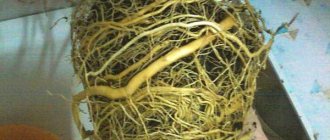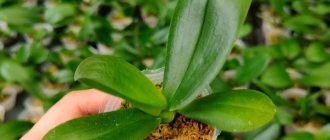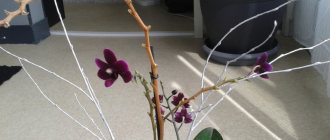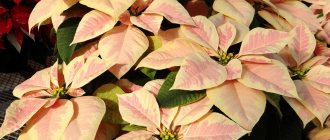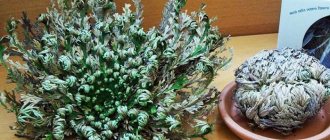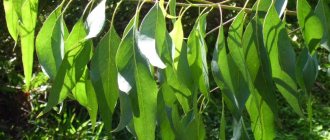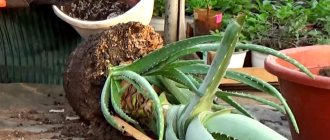Unfortunately, not all plants that grow to the ceiling can be dealt with. Some of them will have to be donated, given away, sold or shared with a neighbor above, if, of course, he agrees to this. When a plant reaches the ceiling, something naturally needs to be done. And, of course, the idea will come to your mind to shorten it, trim it to the desired height. But not all plants can be shortened. Some plants, especially those living in the humid tropics such as palm trees, cannot be pruned. In them, stem growth occurs due to the same apical bud throughout their life. By cutting off a vital “growth point”, we doom the plant to death. But those plants that can use new lateral buds every growing season can and should be pruned. These are all those plants that are easily propagated by cuttings. Let's look in more detail at what can be shortened and how.
So, we remember that the tops of palm trees cannot be cut off; they only need sanitary pruning. The most common palm trees in our homes are: Robelena date, Canary date, chrysolid carpus, howea, chamedorea, chamerops, coconut palm, livistona, rapis. By the way, you can limit the growth of some palm trees, for example, chamedorea, by replanting the plant in the same pot and replacing only the soil.
At home, dracaena, yucca, dieffenbachia, ficus, hibiscus abutilon, coffee tree and schefflera can also easily grow to the ceiling. All these plants can be shortened by following the general and specific rules for pruning indoor plants. We are specifically interested in formative pruning to control plant growth. And the best time to carry it out is spring, the time when active plant growth begins.
Dracaena and yucca are pruned in approximately the same way. Trimming the top of the dracaena to produce side shoots is not difficult. Using a sharp tool you need to trim the dracaena trunk at the desired level. An even cut is immediately sealed with either garden varnish or paraffin. The trunk below the cut is exposed to at least 10 cm of leaves. The upper part of the bare trunk is carefully wrapped in damp sphagnum moss (the cut site remains open) and wrapped in a transparent plastic bag. The plant is placed in a bright place for about a month. The bag must be removed periodically to moisten the moss and inspect the trunk for new shoots. As soon as the shoots appear, the moss and bag are removed and the plant develops without outside help. This way you will reduce the height of the plant and get a more compact bushy flowerpot. Trimmed cuttings can be used for rooting and further replanting, thus creating tiers.
Very often you can see in offices and buildings a dull and spreading Chinese rose, with almost all the branches bare and one or two flowers lost somewhere. Hibiscus easily tolerates all types of pruning, and formative pruning is even mandatory for it. The same applies to abutilone or indoor maple. Moreover, hibiscus blooms on young shoots no older than three years. If you regularly cut off all bending branches and shorten the main branches in the spring, the more compact and dense your plant will be, and the number of flowers will delight you with its abundance. Hibiscus can also be pruned immediately after flowering.
the rubber ficus will only grow upward until it hits the ceiling. You need to trim the top of the ficus to the desired level. You will stop its upward growth and force it to decide to branch laterally. The result can be a nice bush. Working with a sterile instrument will not necessarily process the cut. It is enough to blot it with a damp cloth or sterile bandage. The secretion of milk will soon end, and if it gets on your hands, rinse it thoroughly with water. Other types of ficus (Ficus Benjamin, Ficus Ali, Ficus microcarpa) have a good tendency to branch, but if, nevertheless, the apical bud dominates the axillary ones, they need to be trimmed or pinched in a timely manner.
Dieffenbachia tolerates pruning well . Its cuts must be sprinkled with crushed coal to prevent rotting of the stems and fungal infections. All care work with Dieffenbachia should be carried out wearing protective gloves and protecting your eyes from getting the poisonous juice of the plant into them.
If these are vines with flexible stems, such as monsteras, philodendrons and others, which grew attached to a vertical support, then they can be detached from the support and redirected in other directions. You can also cut them to the desired height, and try to root the cut parts.
Trimming time
The dracaena stem is a structure in which dormant buds are arranged in a spiral along its entire length. This is what makes it possible to obtain seedlings and the beginnings of new branches from a cut made in any part of the trunk.
Planned pruning of dracaena is done during the active growth period, when sap flow is best. There are times when the formation of a bush is needed urgently. For example, part of the stem broke off. Then the shortening must be carried out according to the rules, below the break point. Any pruning can only be effective on a healthy plant.
Self-pruning dracaena - how to do it right
Pruning in itself is stressful for the plant, and if it is done during a period of pronounced dormancy from October to January inclusive, it is doubly painful. The plant is weakened, the healing of cuts and the appearance of side shoots occurs much more slowly, and even the death of the plant is possible during the rehabilitation period. Nevertheless, pruning must be carried out, but the best time for this operation is the period from early spring to early autumn, during the growth phase, when the cut sites heal better and faster and dormant buds awaken.
How to prune dracaena correctly at home
When shortening the central stem, you need to consider several points:
- the top with green leaves should be in a zone of comfortable lighting, so the height of the trunk is calculated for the future growth of branches and leaves;
- for new shoots to appear, it will be necessary to provide the necessary conditions for the germination of new shoots from dormant buds;
- all operations to prepare the correct cut and seal it are carried out under sterile conditions.
You can use a plant for pruning that has 30 cm from the soil to the attachment point of the upper leaves.
Any part of the leafy or bare trunk is cut off. The removed area can be rooted by obtaining another copy of dracaena. Pruning dracaena for branching as an operation is carried out with a sharp knife without squeezing the tissue.
After the top part of the plant is cut off, it can be used to root the top, or cut into 7-10 cm pieces, each of which is capable of producing a new plant. The requirement to cut only with a sharp knife and even cuts is mandatory.
If the stem is leafy at the cut site, the leaves must be removed by 10-15 cm, exposing the trunk. Cover the cut area with garden pitch or melted paraffin so that the inner layer does not evaporate moisture or dry out. The rudiments of new branches should form on the cut. There can be from two to five. But not all germs will grow. The number of new formations depends on the conditions under which germination occurs.
The simultaneous development of all new shoots is achieved due to uniform lighting. Dracaena must be rotated during germination and subsequent care.
Conditions for germination:
- treating the stem with water with the addition of a growth stimulant, for example, Epin;
- creating a damp moss cushion around the open cut of the cambium, the waxed part should be open;
- a plastic bag is tightly secured on top, creating a constant humidity of 75% inside;
- The plant is kept in the light at a temperature of 22-25 degrees for a month.
It is important at this time not to open the cut site, not to remove the bag, and not to change the germination conditions. At the same time, the remaining leaves require watering, and the stem also needs to be moistened. Watering is carried out only by the bottom method, draining the remaining water that has not been absorbed into the earthen lump. It is important that germination is carried out in the light.
As soon as the plant produces buds at the cut site, it is ready to continue development without additional shelter.
It is not necessary that new branches will develop from all the buds that have hatched. Some will not have enough nutrition and will wither away. But you can prune the plant this way many times, renewing it and giving it a new shape.
If the plant has a bare stem, then it is completely placed in the bag after abundant watering. The bag is not removed until the seedlings appear, so as not to disturb the microclimate. The plant is watered through a tray.
When forming dracaena bordered, seedlings can go anywhere along the stem. Then the palm tree will become multi-tiered.
Dracaena: how to form a crown (video)
To branch indoor dracaena, you need to use a standard pruning technique. When performing the initial pruning of tall dracaenas, use a sharp and clean knife to cut off the upper part of the plant, after which the cut area must be treated with paraffin. The trimmed plant should be placed in partial shade, and the temperature regime should be maintained at 24-25°C. In this case, one should not expect too rapid branching of indoor dracaena. As a rule, side shoots begin to actively grow no earlier than three months after the implementation of an activity aimed at branching the stem part of the crop.
If an ornamental plant has been pruned previously, but after this procedure has managed to become very elongated, then formative pruning will need to be done again. In this case, all the tops of the already elongated shoots are carefully, but as evenly as possible, cut off, after which the branches are shortened by cutting at a distance of 20-30 cm from the stem part.
All overground areas that are too deformed and unsuitable for crown formation will also have to be removed. A good visual effect is obtained by shortening shoots at different heights. In any case, all sections obtained as a result of crown formation must be filled with paraffin. It is possible to sprinkle the sections of the sections with crushed charcoal or cover them with special wax for processing the sections , and then treat them with the Zircon preparation, which very well stimulates the branching process.
How to prune a real palm tree and when to do it
Before we talk about pruning a real palm tree, it is necessary to remember once again: this evergreen plant grows at the top, that is, that is where the only point of growth is located. By cutting it, you can destroy the entire tropical tree.
Flower growers with experience in growing palm trees repeatedly focus the attention of beginners on the fact that it is absolutely impossible to prune a palm tree just for the sake of forming a crown. However, there are situations when you still have to pick up a sharp knife or scissors.
Description
Exotic plants, including palm trees, are often grown at home. The most popular varieties are date, dracaena, yucca and some others (in total, about 2000 varieties are known, which differ in the shape of the trunk, height and shape of the leaves). Indoor options are the most popular. These flowers are grown in ordinary pots on windowsills. Caring for them is not as difficult as it might seem at first glance. It is important to observe the nuances, in particular, to prune the plant correctly, removing dried or damaged leaves, tops or inflorescences.
How to trim leaves correctly
With age, as they age, or as a result of errors in care or maintenance, the leaves of the domestic palm tree sometimes turn yellow. The decorative appearance of the plant suffers, and the owner of the palm tree immediately cannot wait to remove the ugly yellow spot against the background of emerald feathery or fan-shaped greenery. There is no point in rushing if it concerns the natural age-related death of the leaf blade.
It has been noted that the sooner a yellowed leaf is removed, the sooner the next one will begin to turn yellow. Therefore, it is necessary to wait until the leaf blade dies off completely, including the petiole, and only then cut it off, but under no circumstances tear it off.
It happens that leaves turn yellow due to failures in care. Part of the leaf has turned yellow, the problem has been resolved, but what to do with a leaf blade that has turned half yellow? You can cut it with sharp scissors, but so that at least a narrow strip of dead tissue remains next to the border with healthy tissue. Otherwise, if you go through the green part of the leaf blade with scissors, the yellowing will continue to spread along it further to the petiole.
How to grow a lot of tops and make dracaena fluffy
Dracaena is a plant that has won the hearts of gardeners with its undemanding care.
Dracaena will decorate any interior. For the normal growth of this flower, you just need to follow these recommendations:
- Make sure the soil is sufficiently dry before watering. To do this, the soil is loosened. If the soil is wet at a depth of three centimeters, then it is better to refrain from watering.
- Those varieties of dracaena with wide leaves drink more water than those with narrow foliage.
- A flower with variegated leaves will grow well if placed on a window on the south side of the apartment.
- Dracaena does not tolerate drafts, scorching sun and accumulation of dust on the surface of the foliage.
- Transplanting from pot to pot should be done together with old soil so as not to damage the root system.
Initially the flower grows into one trunk and it is a little sad. Therefore, some gardeners make the crown fluffy. Before forming a dracaena, the trunk must grow at least thirty centimeters. The trunk must have a diameter of at least five centimeters.
Ten centimeters of the upper part of the flower are cut off. After pruning the dracaena for branching, two or even five new shoots may appear on the trunk. It is recommended to leave the three strongest shoots so that the plant can develop normally and not get sick.
The most popular varieties are:
- Deremskaya;
- Fragrant;
- Frangrance Compact.
When is it appropriate to trim roots?
It is also strictly not recommended to shorten the roots of a palm tree just because they are too long. Palm trees react very painfully to transplantation at any age; when mature, they especially do not tolerate any interference in their root system.
The plant is often replanted by transferring it into a larger vessel with the addition of fresh nutrient soil mixture, or changing the top layer of the earthen clod, removing the depleted one and filling in a new one. After pruning the roots, the palm tree may be in a state of stress for a long time, not grow, often never recovers from this procedure, withers and eventually dies.
However, sanitary pruning of damaged or dead roots found during palm tree transplantation is necessary. It should be done with a sharp, disinfected instrument; the cut areas must be sprinkled with charcoal powder. If there is some other reason for damage to the root system - pests or diseases, the plant should be treated with appropriate chemicals.
Selecting tools and protective equipment
If pruning is truly necessary, you should decide on the appropriate tool. There are many suitable options, the best of which is selected based on the size of the branches and the tree as a whole.
So, you can use:
- A knife with a serrated edge. It is ideal for trimming branches whose diameter is less than 2.5 cm. It can also be used to remove flower stalks.
- Large pruning shears or scissors. Thanks to them, it is easy to remove large branches with a diameter of over 2.5 cm.
- Hand saw. It will allow you to easily get rid of thick and large branches.
- Chainsaw. It is the last possible option, thanks to which you can get rid of the thickest and largest branches.
If you are pruning a large palm tree in your garden, you may need equipment to reach the top of the plant. Depending on the height of the flower, you can use a stepladder or stool, a ladder or even a bucket truck.
Palm tree care after pruning
If you cut off leaves that have died with age, it is not necessary to make any additional adjustments to the usual steps for caring for the plant. In the event that pruning of a palm tree turns out to be forced, associated with errors in the maintenance and care of the plant, you should first eliminate mistakes in care: adjust watering, get rid of pests and cure, if possible, diseases.
In the future, adjust the humidification regime so as to prevent overflow or overdrying of the earthen clod, and also monitor the air humidity and thermometer readings. Be sure to pay attention to other factors that can affect the condition of the crown and root system of the palm tree.
How to stop a palm tree from growing upward?
If a palm tree grows too tall, it may break. avoid this
happened, carry out its initial pruning.
It is advisable not
to allow the dracaena to stretch too much and cut it when its height is 30-40 cm. The stem is cut to the required height to maintain its compact size.
Interesting materials:
Where to relax with your family at sea? Where to relax in Norway in the summer? Where is the cheapest holiday? Where is Defender of the Fatherland Day celebrated? Where to celebrate a birthday in Moscow with your own alcohol? Where is the driver folder? Where is the save folder? Where are the white sand beaches? Where did Marco Polo visit and when? Where did Marco Polo go?
How to prune dracaena correctly
Young dracaenas look like beautiful lush bushes, but with age, with the exception of the bushy dracaena, they grow a thin trunk, and the leaves along it gradually fall off from old age. The result is a leafless pagon with a diameter of 1.5-2 cm and a height of 1 to 1.2 m, and at the top there is a rosette of leaves. The picture is unsightly and not very decorative. In this case, it comes in handy to trim the entire trunk to a level of 10–15 cm above the soil.
It is recommended to carry out the procedure during the active growth period. The plant has adapted to it - dormant buds are located in a spiral along the entire trunk, which sprout shoots immediately after pruning.
Sometimes several side pagons are formed from a cut stump. Excess ones can be removed, since their excessive amount leads to the fact that the plant cannot cope with them, and the weakest shoots die off. It is better to immediately remove those that, by their presence, form a disproportionate crown of the dracaena.
The cut fragment of the stem is used for propagation: the top is rooted separately, and the pagon is cut into cuttings 10–15 cm long each and rooted in a peat-sand mixture in a mini-greenhouse - under glass or a plastic bag. When pruning dracaena, it is important to consider several points:
- carry it out with a sterile instrument;
- the cut areas are covered with garden pitch or molten paraffin;
- When pruning, the blade of the knife or pruner should be at a 90-degree angle to the stem.
Why do you need to prune dracaena?
The sight of thin trunks of dracaenas with a lush spreading bunch of narrow leaves at the top is a familiar sight. And although dracaena has completely different types (with wider, wavy leaves or leafy leaves from the very base for a long time), they are associated precisely with tree-like forms. Changeable, at the same time similar and so different, it is no coincidence that dracaenas have become favorites. After all, their reputation as the easiest “false palm” to grow is largely justified, even if growing dracaenas has its own nuances.
Dracaenas do not grow very quickly, but literally as they want, irreversibly changing and stretching over time. Pruning is the only way to create multi-stemmed bushy forms, control height, and rejuvenate dracaenas. After all, these false palms, unlike cordylines, do not form stolons and do not bush themselves.
Typically, flower growers are very afraid of pruning dracaenas on lignified palm-shaped trunks, slightly confusing dracaenas with genuine representatives of the Palm family, which cannot tolerate unnecessary interference and do not survive injuries to the trunk. But there is absolutely nothing to fear. Rejuvenation by pruning must be done according to the rules, but very simple. Pruning dracaena does not involve any special secrets or difficulties.
No matter how thick, hard and dry the lignified trunk of dracaena may seem, dormant buds remain on it, capable of starting to grow. Even very old and badly damaged dracaenas will grow back (of course, if their roots are healthy, the plant has not rotted or dried out completely). And the tops take root very easily.
As a result of rejuvenation by pruning you get:
- several growing points on the old trunk - multi-headed dracaenas;
- a young replacement plant, a compact rosette on a rooted top;
- several plants of the same species for planting in identical containers and displaying in a “series”, or for planting in one container to obtain a multi-stemmed effect.
Pruning dracaena. © greensotka
Features of pruning yucca and cordyline
Unlike dracaena, yucca needs to be pruned when it just comes out of dormancy, around the end of February - March. Pruning done after mid-March can lead to the death of the plant.
Flower growers with experience in growing this false palm say that you should not start pruning plants whose trunk diameter has not reached 5 cm, because after the procedure it will remain that way - thin and ugly. Tall specimens are trimmed, in which the cutting point is no lower than 50 cm above the level of the earthen clod.
Both the cut and the severed part of the stem lose moisture very quickly, so they are dried for a couple of hours and poured with molten paraffin. After pruning, the plant is placed in partial shade and watered infrequently (once a week) for 2 months until it recovers from stress. During this period, buds appear below the cut and young shoots appear. There may be 4–5 or less. In any case, no more than five should remain, the rest must be removed, the sooner the better, so as not to drain the juices from the yucca.
Pruning cordyline is similar to pruning the already mentioned false palms. The only emphasis is that the cut should be located in a place on the trunk where it is already mature and not green. The remaining rooting steps are the same as with dracaena and yucca. One note - after pruning the cordyline, in addition to producing lateral shoots, it can also produce root shoots. Depending on its quantity, the gardener decides whether to plant it in another pot or leave root shoots near the mother plant in order to get a new attractive lush bush.
Trimming instructions
Trimming your favorite dracaena at home is not as difficult as it seems. First, arm yourself with a sharp knife. Choose the cutting height at your discretion, but the optimal distance is considered to be 20 cm from the top. With a confident movement, we cut off the trunk in the place where branching should appear later. The cut part of the palm tree can also be used: leave it to dry for several days, and then place it in water to form roots. When they appear, the seedling can be planted in a permanent place in the ground.
But let's return to the main plant. The cut site requires mandatory treatment to avoid rotting. It is better to use crushed activated carbon or molten paraffin (remember bamboo, which was popular a few years ago?). After carrying out all the manipulations, intensively spray the palm tree with water for several days - during this time it intensively loses moisture. Now we place the pot in a dark and warm (+25 degrees) place without drafts. At home, you will have to wait at least a month for the appearance of young leaves. Once they appear, you will be convinced that your efforts were not in vain.
That's all the wisdom on how to prune dracaena at home. As you can see, it's not difficult!
Do I need to prune pandanus?
In terms of pruning, pandanus is closer to true palms than to false palms. It cannot be pruned in the same way as dracaena or yucca. There is no rush to remove the dried tips of the leaves, and if this has to be done, the living tissue on the leaf blade is not affected, leaving approximately 1–2 mm of dead area at the border with the healthy leaf.
In mature specimens, aerial roots form at the base of the stem. They should also never be cut off. If children form on the side of the trunk, they are separated only after they have grown their own roots at least 5 cm long. They are not cut, carefully broken off by hand, dried for a while and rooted in a constantly damp peat-sand mixture at a temperature of at least 20 degrees heat.
Further care
The plant is placed in a warm room where the air temperature does not drop below +20 degrees. If pruning is carried out in winter, additional artificial lighting is installed above the crop. The flower is protected from drafts; temperature changes can quickly destroy it.
3-4 days after pruning, the plant is fed with nitrogenous fertilizers to awaken the buds. Fertilizing is carried out after abundant watering. To do this, you can use ammonium nitrate (1 tsp per 3 liters of water).
Fertilizer is administered once every 14 days for 3 months until the side shoots grow to 6 cm in length. Watering is carried out as the soil dries with warm, settled water. Since the palm tree prefers high humidity, the trunk is sprayed once every 7 days. To ensure uniform fouling of the crown, the pot with the plant is periodically turned towards the light.
How to use cut parts of dracaena
All trimmed parts can be planted by rooting in a nutrient substrate or water. Additionally, you can process sections of harvested dracaena cuttings with “Kornevin”. In order for the rooting of planting material to be as easy and quick as possible, the pot with the plant to be rooted must be covered with a plastic bag, which will help create optimal temperature conditions and high humidity. The appearance of new leaves indicates the plant is ready to be transplanted to a permanent location.
When to prune
Is it possible to prune dracaena at your discretion? Sanitary pruning can be carried out at any time of the year. Activities are carried out as needed. Diseased and rotting shoots should be immediately removed from a diseased plant. Remove all rotting parts. Appearance can be ignored here; the main thing is to preserve the flower. Later, when it looks healthy, you can start decorating it.
The requirement for decorative pruning has stricter deadlines. It is recommended to carry it out in the spring (April, May), when the plant wakes up from hibernation and begins to grow. The juice should actively run along the stems. Pruning for flowers is tantamount to surgery and is always stressful. The plant needs time. It is not recommended to prune shoots in summer when the weather is hot and dry.
There are several requirements that you need to know before updating your dracaena:
- the plant must be healthy;
- use only sharpened and sterile instruments to prevent the possible risk of infection;
- The cut just made is sprinkled with crushed activated charcoal;
- treat with growth stimulants;
- the recommended room temperature should not exceed 25 °C;
- humidity about 75%.
But how do you understand that it’s time to carry out an event to improve the appearance of dracaena? You need to pay attention to the following factors:
- the plant has only one trunk (there are no more leaves at the bottom, and there are clearly not enough leaves at the top);
- the palm tree has become too tall (2-2.6m);
- grown shoots look ugly or deformed.
What types of palm trees are there?
Palm trees, variety of species
- Indoor palm tree
. © landmarkafterdark. - A palm tree
can decorate any interior. ... - palm
(Brahea edulis). ... - Butia palm
(Butia capitata). ...
Washingtonia filifera palm ...
Hyophorbe palm ...- Palm
Chamaedorea. ... - Palm
Caryota.
How to plant dracaena: transplant procedure
Before planting dracaena cuttings that have given roots, you need to prepare special soil and pots.
The pots should not be very large; 2-3 sprouted cuttings can be planted in one. Convenient and practical are plastic flowerpots with a hole in the bottom that guarantees drainage of excess liquid.
How to plant young rooted dracaena:
- pour a layer of drainage material – small pebbles, expanded clay – onto the bottom of the pot;
- pour soil for indoor plants or soil for palm trees into the pot (2/3 of the volume);
- plant the cuttings, sprinkle with soil and compact the soil;
- water thoroughly.
When deciding on how to plant dracaena, you need to take into account the age and condition of the parent plant, its appearance and conditions of detention. For example, the small green variety Dracaena compacta propagates well from its tops; varieties with variegated leaves are preferably planted vegetatively.


